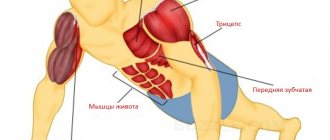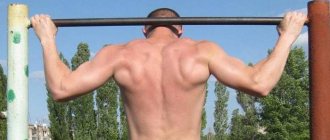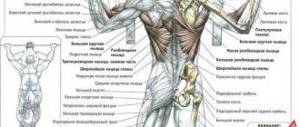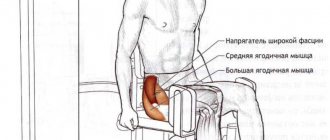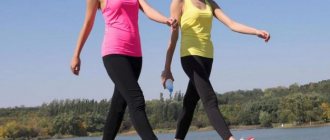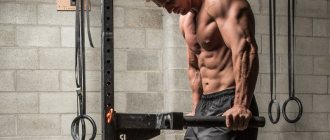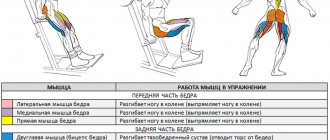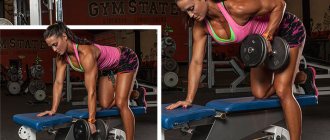To achieve success in sports and maintain body tone, regular training is necessary. But you don’t always have the finances and the ability to go to the gym? The solution will be a simple, economical tool that allows you to quickly tighten and rejuvenate your body at minimal cost - this is a jump rope. For classes you will need inexpensive equipment, a pair of sneakers and 30-60 minutes of free time a day. This article will tell you what the benefits of a jump rope are and what muscles are involved when performing jumps.
Skipping efficiency
Professional athletes know that the most effective for losing weight and correcting body volume is a complex consisting of:
- balanced nutrition;
- muscle and cardio training.
Skipping will provide effective cardio and muscle training. Let's look at what muscles are involved when jumping rope.
The effects of skipping on human muscles
What muscles work when jumping rope? During training, almost the entire body works. The muscles most actively involved in the lower body are the calves, glutes, thighs and core. The main load (60-70%) when jumping falls on the calf muscles located on the back of the leg, between the knee and ankle.
Attention: the calves work actively during training, so after intense jumps they get tired and hurt.
Visualization of which muscles the jump rope works in the lower part of the legs
What does a jump rope do besides the lower legs? Active work during jumping is performed by the muscles of the buttocks and thighs. About 15% of the load falls on the quadriceps - this figure depends on the technique of performing the exercises.
Legs and buttocks are an example of which muscles sway when jumping rope
The muscles of the core (torso) take part in jumping - the rectus abdominis, obliques, sartorius, back extensors, and latissimus. They perform the function of a body stabilizer, taking on only 10% of the load.
Note: the only muscles that are trained under static loads are the cortex.
The core muscles stabilize and hold the spine, this is what the jump rope trains
Minor loads when jumping fall on the muscles of the arms and shoulders. What muscles are affected by jumping rope in this area? First of all, on the biceps and triceps. The muscles of the forearm and deltoid also work.
Note: the shoulder girdle and arms are only slightly involved when performing jumps, so it will not be possible to strengthen their relief by performing exercises.
Jumping rope - what muscles work in the upper body
Each of the above muscles can be worked at varying degrees of intensity. Depending on the way you perform the exercises, certain tissues are involved. Knowing which muscles the jump rope trains, you can create a training program aimed at eliminating individual problems.
Note: the more varied the jumps, the more muscles are involved in the training.
Jump rope - which muscles are used the most, diagram
How many calories does jumping rope burn?
If you are interested in whether jumping rope helps you lose weight, then you only need to provide the average calorie consumption figures. For example, with a weight of 60 kg, an average of 750 kcal is consumed in one hour of exercise. The figure largely depends on the speed and number of repetitions, and the initial weight. There is one immutable rule: the more jumps performed per minute, the greater the calorie consumption.
More accurate information according to your parameters can be found in the table of energy consumption. It is based on the average number of jumps per minute – 120-150.
| Weight/duration | 5 minutes | 10 min | 15 minutes | 30 min | 45 min | 60 min |
| 50 kg | 55 kcal | 110 kcal | 165 kcal | 307 kcal | 490 kcal | 650 kcal |
| 55 kg | 60 kcal | 120 kcal | 180 kcal | 360 kcal | 540 kcal | 720 kcal |
| 60 kg | 65 kcal | 130 kcal | 200 kcal | 400 kcal | 390 kcal | 785 kcal |
| 65 kg | 70 kcal | 140 kcal | 215 kcal | 425 kcal | 640 kcal | 850 kcal |
| 70 kg | 75 kcal | 150 kcal | 230 kcal | 460 kcal | 685 kcal | 915 kcal |
| 75 kg | 80 kcal | 160 kcal | 245 kcal | 490 kcal | 735 kcal | 980 kcal |
Is it possible to pump up your buttocks, legs and calves when doing skipping?
Ideal buttocks have a smooth, convex shape, consist of muscles, without fat and traces of cellulite. How to tighten your butt, increase its elasticity, and get rid of sagging in the hip-femoral area?
An effective remedy is a jump rope for the buttocks and thighs. When performing high jumps, the iliacus, quadriceps, and biceps muscles are trained.
It is important to know when jumping rope which muscles work the most intensely.
Which jump ropes are best to use?
There are a huge number of options for jumping ropes on the market: simple ones for children, sports ones with a built-in spin counter, jumping ropes for singles, pairs and group jumps.
When choosing a rope, pay attention to its weight: if it is too light, such a rope will not rotate well.
And, of course, all jump ropes are designed for a certain person’s height. It’s easy to choose its length: stand in the middle of the rope (feet together) and see if it reaches your armpits. If it does, then the jump rope is suitable for you.
For beginners, the simplest jump ropes are suitable, which can be bought for a small price in a regular hypermarket. But for an advanced level of jumping, we recommend purchasing a high-speed jump rope from a sports store.
What is a speed jump rope? This is a jump rope used for high-speed jumping techniques. It is inconvenient to perform double and triple jumps on a simple apparatus, but a high-speed jump rope is designed for this. It uses a PVC-sheathed metal cord and metal bearings to secure the cord. This gives the rotation speed.
Among the advanced jump ropes there are also equipment with weights in the handles. This allows for a great workout on your forearms.
Does skipping work on the abs? Is it possible to pump them up using a skipping rope?
The load on the press when skipping is only 5%. This group of muscles only supports the body when jumping, so it will be possible to develop and pump them up.
For targeted training of this zone, you will need to make additional efforts - jumping on your toes, raising your legs high, pressing your hips to your body. Noticeable results will appear after 5-10 sessions.
To burn fat in the lower abdominal area, you need to take a comprehensive approach:
- adjust nutrition - before pumping up your buttocks, eliminate excess weight, as this causes stress on the blood vessels and heart. A proper diet will ensure optimal intake of calories into the body;
- regularly perform exercises with a skipping rope - jumping, raising your legs and upper body above the ground, turning, bending. These exercises warm up and pump up the muscles. When performed intensively, the remaining fat deposits are eliminated and the muscles are toned.
An example of exercises with a skipping rope for the press in the photo above
Jumping rope program for weight loss
Perform training every other day, performing the specified number of jumps. If necessary, you can pause between jumps.
| Day | Number of jumps |
| 1 | 100 |
| 2 | 130-150 |
| 3 | 150-180 |
| 4 | 180-210 |
| 5 | 210-240 |
| 6 | 240-270 |
| 7 | 270-300 |
| 8 | 300-330 |
| 9 | 330-360 |
| 10 | 360-390 |
| 11 | 390-420 |
| 12 | 420-450 |
| 13 | 450-480 |
| 14 | 480-510 |
| 15 | 510-550 |
More programs with a jump rope for weight loss →
conclusions
Many people do not include skipping in their body training program because they do not know what swings when jumping rope. But these exercises are the best option for simplicity and effectiveness.
What swings when you jump rope? The exercises involve almost all the muscles of the body - legs, torso, arms. To achieve results, you need to observe, while jumping rope, which muscles pump the fastest, and select a set of exercises aimed at eliminating your individual problems.
Skipping is a sport that does not require a lot of time and money to practice. It perfectly tightens the body, strengthens, and pumps up muscles.
How much and how to jump?
To achieve the desired result, you need to constantly train. The whole point is the frequency of training, its intensity and the technique of performing the exercise. The optimal workout length is 10 minutes or more. If you are a beginner, then start from the minimum. As you develop technique and endurance, you can train longer. When your legs and core muscles become stronger, they will not hurt.
Studies have shown that approximately 15 jumping ropes can burn about 220 calories. The intensity of the workout should increase gradually. It is advisable to exercise outdoors. If possible, the elbows are pressed against the body, and during the exercise, only the hands perform rotational movements.
Home workout program
Jumping without a rope is easy to do. There are many variations of these exercises. For example, perform them on 2 legs, and then start changing them. You can jump while squatting. If you have mastered simple types, you can complicate the lessons by adding the “Scissors” element.
Jumping, in which you spread your legs to the side and clap your hands above your head, will help you effectively get rid of excess weight. This type of load should be at least 35–30 minutes. If a person has a high level of physical fitness, he can do jumping for up to 50 minutes. How many times a week to conduct such training depends on how many kilograms you plan to lose. However, to stay fit, experts recommend doing such fitness exercises at least 3 times a week, and more often if necessary.
If you decide to use weights, then for these purposes you should take dumbbells whose weight ranges from 0.5 to 1 kg.
To diversify the program, during the jumping process you can bounce to the right and left, and then forward and backward. This approach increases the number of muscle groups involved.
The performance of jumps largely depends on the experience of the trainee and his ability to feel his body. You can combine the exercise with elements of running, squats, or bending in different directions.
Such a complex requires the presence of a sufficient amount of space, since restrictions will reduce the efficiency of this type of load. Therefore, when training at home, you should allocate the maximum amount of space for jumping.
Since the lungs work intensively under such a load, the room should be ventilated before starting exercise. It is also necessary to carry out wet cleaning regularly so that the body receives oxygen and not dust.
Sometimes after jumping you may experience pain in the area:
- knees;
- calves;
- joints may ache.
The expected weight loss effect is absent. This indicates that during training mistakes were made in the technique of performing jumps.
Thus, many people perform jumps with straight legs, while they need to do jumping with their knees slightly bent.
The surface on which the jumper lands and the shoes he uses for training are of great importance. It is better to cover the floor with a special mat, which will make it possible to absorb the jump. The sole of the shoe should be elastic, but not hard. Light sneakers or sneakers are suitable.
However, it is not enough to perform the jumps correctly. To lose weight, exercise must be combined with changes in diet. A person who wants to get rid of extra pounds and build muscle mass should exclude sweet and fatty foods from the menu, as they make it difficult for the pancreas to function, minimizing the benefits of training.
You should reduce your salt intake. It is necessary to drink as much clean, filtered water as possible, which will help remove harmful substances from the body and improve metabolic processes.
Contraindications and possible harm
A jump rope is one of the safest sports equipment, however, it also has contraindications:
- diseases of the spine during an exacerbation, displacement of the vertebrae or cartilage, when there are contraindications to jumping;
- high obesity index if there is a possible risk of joint damage and excessive stress on the legs;
- vein diseases;
- hypertension and cardiac dysfunction;
- arthritis and arthrosis;
- some eye diseases.
To avoid unpleasant consequences, it is necessary to familiarize yourself with the jumping technique before starting classes. Comfortable shoes, fresh air, energetic music and enough water will make the workout as enjoyable and effective as possible.


